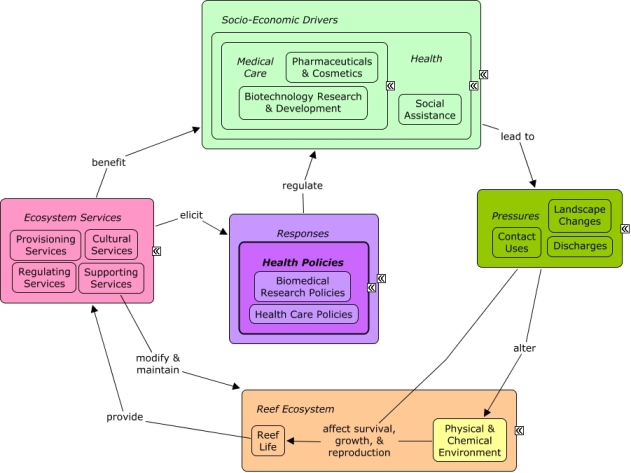ReefLink Database

Biomedical Research Policies
Biomedical research policies, including research funding and patent laws regarding natural biochemicals, can influence the demand for biochemicals and the activities of research and development.
CMap

CMap Description
A change in the provision of ecosystem services, or a desire to improve provision of ecosystem services, may elicit responses to manage the distribution and functioning of health sectors. Biomedical research policies, including funding and patent laws, can influence the demand for biochemicals and the activities of research and development. Health sectors benefit from reef ecosystem services, including provisioning of marine products and natural waste management through nutrient and contaminant processing.Citations
| Citation | Year | Study Location | Study Type | Database Topics |
|---|---|---|---|---|
| Burke, L., K. Reytar, M. Spalding, and A. Perry. 2011. Reefs at Risk Revisited. World Research Institute, Washington, D.C. (USA). | 2011 | Panama; Tanzania; Indonesia | Biomedical Research Policies; Fish; Funding & Donations; Funding & Incentives | |
| Harrison, P. A., M. Vandewalle, M. T. Sykes, P. M. Berry, R. Bugter, F. de Bello, C. K. Feld, U. Grandin, R. Harrington, J. R. Haslett, R. H. G. Jongman, G. W. Luck, P. M. da Silva, M. Moora, J. Settele, J. P. Sousa, and M. Zobel. 2010. Identifying and prioritising services in European terrestrial and freshwater ecosystems. Biodiversity and Conservation 19:2791-2821. | 2010 | Europe | Review | Agriculture; Biochemical & Genetic Resources; Biomedical Research Policies; Climate; Climate Regulation; Cultural Policies; Cultural Services; Existence Value & Sense of Place; Fishing Sector; Forestry; Non-Monetary Valuation; Pathogens; Pharmaceuticals & Cosmetics; Provisioning Services; Recreational Opportunities; Regulating Services; Seawater Flow; Special Use Permitting; Surface & Groundwater Flow; Tourism & Recreation; Tourism & Recreation Policies; Wetlands |
| Hunt, M. E., M. P. Scherrer, F. D. Ferrari, and M. V. Matz. 2010. Very Bright Green Fluorescent Proteins from the Pontellid Copepod Pontella mimocerami. PLoS One 5:e11517. | 2010 | Decision Support Frameworks & Tools | Biomedical Research Policies; Microorganisms; Pharmaceuticals & Cosmetics; Pharmaceuticals & Cosmetics Sources | |
| Check, W. 2009. DNA sequencing grows virtuosic - And deep. Microbe 4:18-22. | 2009 | Biomedical Research Policies; Microorganisms; Pathogens; Pharmaceuticals & Cosmetics; Pharmaceuticals & Cosmetics Sources | ||
| Lin, M. Z., M. R. McKeown, H. L. Ng, T. A. Aguilera, N. C. Shaner, R. E. Campbell, S. R. Adams, L. A. Gross, W. Ma, T. Alber, and R. Y. Tsien. 2009. Autofluorescent Proteins with Excitation in the Optical Window for Intravital Imaging in Mammals. Chemistry & Biology 16:1169-1179. | 2009 | Decision Support Frameworks & Tools | Biomedical Research Policies; Pharmaceuticals & Cosmetics; Pharmaceuticals & Cosmetics Sources | |
| Schlesinger, A., E. Kramarsky-Winter, and Y. Loya. 2009. Active Nematocyst Isolation Via Nudibranchs. Marine Biotechnology 11:441-444. | 2009 | Decision Support Frameworks & Tools | Anemones & Zooanthids; Biomedical Research Policies; Discharges; Pharmaceuticals & Cosmetics; Pharmaceuticals & Cosmetics Sources | |
| Balmford, A., A. S. L. Rodrigues, M. Walpole, P. ten Brink, M. Kettunen, L. Braat, and R. de Groot. 2008. The economics of biodiversity and ecosystems: scoping the science. European Commission, Cambridge, UK. | 2008 | Global | Review; GIS & Maps | Aquaculture; Biological Monitoring, Mapping, & Scientific Research; Biomedical Research Policies; Climate; Fishing Sector; Forestry; Monetary Valuation |
| Nassiri, N. 2007. Industry news: Biocoral wins French patent after three years. Pages 7-Jun Biomedical Materials. | 2007 | France | Pharmaceuticals & Cosmetics; Pharmaceuticals & Cosmetics Sources | |
| Martin, C., H. G. Deters, and T. W. Nattkemper. 2006. Fusing biomedical multi-modal data for exploratory data analysis. Lecture Notes in Computer Science (including subseries Lecture Notes in Artificial Intelligence and Lecture Notes in Bioinformatics) 798-807. | 2006 | GIS & Maps | Biomedical Research Policies; Collaboration & Partnering; Fish; Pharmaceuticals & Cosmetics; Pharmaceuticals & Cosmetics Sources | |
| Morgan, S. K. and S. A. Lourie. 2006. Threatened fishes of the world: Hippocampus comes cantor 1850 (Syngnathidae). Environmental Biology of Fishes 75:311-313. | 2006 | Global; Thailand; Malaysia; Vietnam; Indonesia; Philippines | Field Study & Monitoring; Decision Support Frameworks & Tools | Accidental & Illegal Harvest; Aquarium & Pet Trade; Biomedical Research Policies; Climate; Collaboration & Partnering; Complex Habitat & Resources; Finfish Harvest; Fishing Sector; Lobster, Crab, & Shrimp; Marine Protected Areas; Pharmaceuticals & Cosmetics; Seagrasses; Sponges; Stony Coral; Substrate |
| Reed, J. K., D. C. Weaver, and S. A. Pomponi. 2006. Habitat and fauna of deep-water Lophelia pertusa coral reefs off the southeastern U.S.: Blake Plateau, Straits of Florida, and Gulf of Mexico. Bulletin of Marine Science 78:343-375. | 2006 | South & Central America; Florida; US East Coast (NC, SC, GA); Mexico | GIS & Maps | Biomedical Research Policies; Fish; Fishing Sector; Marine Protected Areas; Pharmaceuticals & Cosmetics; Pharmaceuticals & Cosmetics Sources; Pipelines; Trawling & Fishing Gear Damage |
| Shrestha, S. and S. K. Deo. 2006. Anthozoa red fluorescent protein in biosensing. Analytical and Bioanalytical Chemistry 386:515-524. | 2006 | Biomedical Research Policies; Pharmaceuticals & Cosmetics; Pharmaceuticals & Cosmetics Sources | ||
| Tibbetts, J. 2004. The state of the oceans, part 2: delving deeper into the sea's bounty. Environmental Health Perspectives 112:A472-481. | 2004 | Global | Index or Indicator | Agriculture; Biomedical Research Policies; Climate; Finfish Harvest; Non-point Source Runoff; Nutrients; Pharmaceuticals & Cosmetics; Pharmaceuticals & Cosmetics Sources |
| Firn, R. D. 2003. Bioprospecting - why is it so unrewarding? Biodiversity and Conservation 12:207-216. | 2003 | Columbia | Funding & Donations; Funding & Incentives; Pharmaceuticals & Cosmetics; Pharmaceuticals & Cosmetics Sources; Surface & Groundwater Flow | |
| White, E. W. 1997. Biomaterials innovation: It's a long road to the operating room. Materials Research Innovations 1:57-63. | 1997 | Review | Pharmaceuticals & Cosmetics; Pharmaceuticals & Cosmetics Sources | |
| Principe, P. P. 1996. Monetizing the pharmacological benefits of plants. Pages 192-218 in Balick, M. J., E. Elisabetsky, and S. A. Laird, editors. Medicinal resources of the tropical forest: biodiversity and its importance to human health. | 1996 | Biomedical Research Policies; Health Policies; Valuation |
Management Options
| Management Option | Description | Sources | Database Topics |
|---|---|---|---|
| Corporate Response: Invest & Co-finance Projects | Investing and co-financing projects that aim to conserve or restore habitats can be an effective means to preserving reef habitats as well as establishing positive working relationships between organizations. Investing in private sector projects will promote desired businesses and business practices, reducing barriers to entry and competitiveness as compared to traditional businesses and business practices to counterbalance advantages from undesired externalities. | World Bank Group. 2008. Biodiversity, Climate Change, and Adaptation. Nature based solutions from the world bank portfolio. The International Bank for Reconstruction and Development, Washington, DC. |
Aquarium Stock; Banks, Credit, & Securities; Biochemical & Genetic Resources; Biomedical Research Policies; Collaboration & Partnering; Corporate Responses; Economic Markets & Policies; Finance & Insurance; Finfish & Shellfish Stock; Food & Raw Materials; Funding & Donations; Funding & Incentives; Manufacturing & Trade; Manufacturing & Trade Policies; Marine Products; Ornamental Jewelry & Art; Pharmaceuticals & Cosmetics Sources; Provisioning Services; Resource Use Management; Tourism & Recreation |
| Marine Zoning: Special Use Areas | Special use areas are set aside for specific scientific or educational purposes. This is in order to encourage the recovery or restoration of injured or degraded resources. Also, the areas may be designated to facilitate access to, or use of, resources, and prevent other user conflicts. Special-use areas are achieved through a variety of methods such as: placing/maintaining buoys along zone boundaries; adjusting boundaries if necessary; evaluating allowable activities within zone boundaries; identifying potential areas that need additional zoning; reviewing the effectiveness of the zoning; and revising NOAA and GIS charts; and determining/establishing appropriate zones for high-impact or user-conflict activities. | NOAA Marine Sanctuary Program. 2007. Florida Keys National Marine Sanctuary revised management plan. National Ocean Service, Key West, FL. |
Biological Addition; Biological Harvest; Biological Monitoring & Restoration; Biological Monitoring, Mapping, & Scientific Research; Biomedical Research Policies; Complex Habitat & Resources; Contact Uses; Cultural Services; Decision Support; Designated Uses; Ecosystem Monitoring & Restoration; Education & Information; Educational & Research Opportunities; Environmental Education & Outreach; Environmental Monitoring & Restoration; Environmental Monitoring, Mapping, & Scientific Research; Health Policies; Marine Protected Areas; Permitting & Zoning; Physical Damage; Provisioning Services; Resource Use Management; Scientific Research; Social Organizations; Special Use Permitting; Supporting Services; Wetland & Reef Restoration |
| Monitor & Research: Develop Scientific Research Study Program | Management areas can encourage scientific studies by coordinating efforts of research groups and institutions. Collaboration and integration of these scientific studies can be beneficial to both the research groups and the management area. For example, data from monitoring of restoration projects could be analyzed by an academic institution, helping to reduce the burden on funds and perhaps using data in ways outside the scope of management objectives. | NOAA Marine Sanctuary Program. 2007. Florida Keys National Marine Sanctuary revised management plan. National Ocean Service, Key West, FL. |
Biological Monitoring & Restoration; Biological Monitoring, Mapping, & Scientific Research; Biomedical Research Policies; Collaboration & Partnering; Cultural Policies; Cultural Services; Decision Support; Ecosystem Monitoring & Restoration; Ecosystem Services; Education & Information; Educational & Research Opportunities; Environmental Education & Outreach; Environmental Monitoring & Restoration; Environmental Monitoring, Mapping, & Scientific Research; Resource Use Management; Schools & Colleges; Scientific Research; Security & Public Administration Policies; Special Use Permitting |
Laws
| Legal Citation | Purpose of Law | Management Organization | Database Topics |
|---|---|---|---|
| Total maximum daily loads, 62-304 Florida Administrative Code Annotated (2006). | The Chapter establishes Total Maximum Daily Loads (TMDLs), and their allocations, for waters that have been verified to be impaired by a pollutant pursuant to Chapter 62-303. F.A.C. Application to Coral Reefs:By regulating the amount of pollutants that will be allowed to be discharged into major waterbodies of the state, the amount of pollutants reaching estuarine and then marine environments, and eventually coral reefs, will assist in protecting the reefs and other habitats. Legislative Actions:The planning list of impaired water bodies has been completed. Data on each water bodies has been collected. DEP is in the process of calculating TMDLs for each water body. Comments: |
Florida Department of Envitonmental Protection Jurisdiction: United States; State Coastal Waters |
Agriculture, Aquaculture, & Forestry Policies; Aquaculture; Ballast Discharge; Biomedical Research Policies; Coastal Development; Deforestation & Devegetation; Ditching & Soil Disturbance; Dredging Regulations; Finfish & Shellfish Stock; Impervious Surfaces; Irrigation; Landuse Management; Metals, Electronics, & Machinery Products; Nutrient & Contaminant Processing; Nutrients; Physical & Chemical Water Quality Criteria; Point Source Discharges; Resource Use Management; Sediment; Sewage Treatment; Shoreline Armoring; Solid Waste Disposal; Waste Management Policies; Wastewater Discharge; Wetland & Reef Restoration; Wood, Plastics, & Chemical Products |
